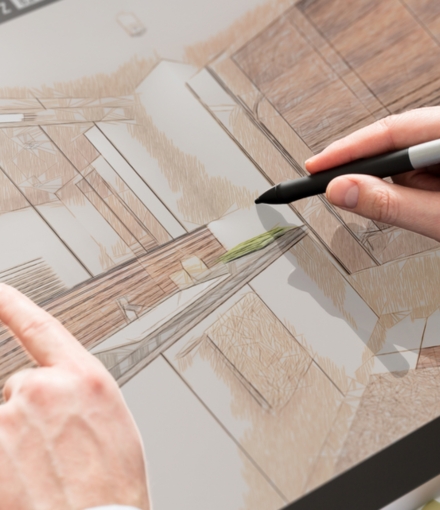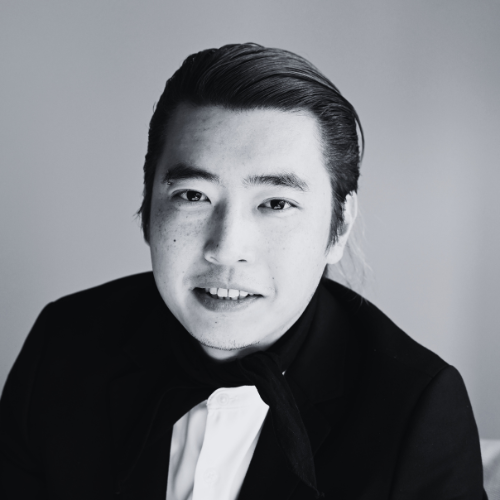ELEVATING DESIGN EXPERTISE





ELEVATING DESIGN EXPERTISE
In the advanced stage of our interior design program, students gain the expertise to develop professional design proposals tailored to real-world scenarios in the industry. Equipped with foundational skills acquired in previous levels, students refine their proficiency in digital design software, underpinned by a deeper understanding of instructional methodologies. Faculty members recognize leaders in the field who provide guidance throughout the process, ensuring students master each stage of design technique, ultimately preparing them for successful careers in the profession.
In Level 4 of the Interior Design program, students explore the relationship between design elements and user experience in interior projects. They investigate how the intentional application of color, lighting, and materials might enable architectural interpretations to achieve sensory design objectives. Students learn to combine standard interior architectural features with specialized functionality to create unique and immersive places. One area of particular emphasis is the implementation of these ideas inside wellness spa designs. Students work on developing their abilities to incorporate technical elements and interior visual standards into their designs through industry-based learning throughout the curriculum. Additionally, they delve into the business aspects of interior design, gaining insights into various career paths and the field’s interdisciplinary nature. In the Design and Presentation Lab, students refine their skills in producing realistic renderings, incorporating materials and light effects to communicate their design concepts effectively.
Through strong industry connections and opportunities for experiential learning, students at Istituto Marangoni Miami are well-positioned for professional growth within the field of interior design education. Our program is a shining example of thorough preparation, giving students a deep understanding of market dynamics necessary for job success. Students in the Miami Design District are exposed to professionals in the field and are given unique opportunities for immersive learning thanks to more than 80 collaborations with prestigious brands. In addition to these opportunities, our committed career services team offers specialized assistance, helping students with job applications, interview preparation, and resume creation so they can successfully fulfill their professional goals.
Our campus at Istituto Marangoni Miami is housed in a cutting-edge, 7-story building in the center of the Design District. Every level is planned to meet the various needs of our students, offering them a creative space that fosters learning and growth. Our program provides a comprehensive learning environment comprising theory classrooms, studio labs, materials labs, and computer labs equipped with industry-standard software like AutoCAD, Adobe Cloud, SketchUp Pro, Revit, Enscape, and Lumion. These tools empower students to learn and create effectively in every aspect of their interior design coursework.
Students can progressively learn with these tools within their program design courses and start building their professional interior design portfolio. These include a comprehensive library, both physical and virtual, stocked with essential references and research materials. Our interior design students also have the opportunity to learn about industry materials and projects that enhance their learning experience through luxury design houses near the area. To learn more about our facilities and resources, visit our Miami campus or schedule a virtual tour to get to know us better.
If you are interested in applying to our Vocational Program in Interior Design, Level 4, the first step is to schedule an appointment with an admissions representative. To apply to this level directly, you must have a portfolio review by our Academic Committee or have completed the previous levels of this program. Once completed, a detailed email will be sent with instructions on how to proceed with your registration: document submission and visa application, if applicable. International students will have further assistance throughout their visa solicitation process with our Designated School Official (DSO). Once your registration has been completed, you will receive instructions about housing options, orientation, and more.
CURRICULUM
In Level 4 of the Interior Design Vocational Program, students explore innovative approaches to redefine the essence of interior spaces, pushing beyond conventional design norms. Students explore the complexities of designing spaces that prioritize user well-being first, with an emphasis on sensory and experiential design. Students create immersive environments that stimulate emotions and enhance the human experience by combining architectural features, materials, lighting, and color. After completing Level 4, students can redefine interior design with the help of industry specialists and practical projects.
| Number | Course Title |
|---|---|
|
ID401
|
SENSORIAL AND EXPERIENTIAL DESIGN
Apply a sensorial and experiential design theory to create a user-centered environment that improve well-being. SENSORIAL AND EXPERIENTIAL DESIGN
Hidden Details
Show Details
|
|
ID401L
|
LAB
Demonstrate the design ability to integrate interior graphic standards, technical aspects, and components. |
|
ID403
|
ADVANCED VISUAL PRESENTATION
Produce realistic renderings with materials and light effects. ADVANCED VISUAL PRESENTATION
Hidden Details
Show Details
|
|
ID404
|
BUSINESS OF INTERIOR DESIGN
Discuss the various careers that cross over art and design and the other affiliated disciplines in textiles, furniture, lighting design, LEED accreditation, construction management among many others. BUSINESS OF INTERIOR DESIGN
Hidden Details
Show Details
|
|
ID405
|
INDUSTRY-BASED LEARNING
Identify the essential needs of the main project for effective design documentation. INDUSTRY-BASED LEARNING
Hidden Details
Show Details
|
TUITION AND FEES Level 4 | Interior Design Redefined
| Cost and Fees | Level 1 | Level 2 | Level 3 | Level 4 | One-Year Program |
| Tuition Cost | $12,000 | $10,000 | $8,000 | $8,000 | $38,000 |
| Non-Refundable Application Fee* | $100 | ||||
| Semester Campus Fees | $250 | $250 | $250 | $250 | $1,000 |
| Semester Digital Resource Fees* | $350 | $350 | $350 | $350 | $1,400 |
| Semester Books and Supplies* | $200 | $200 | $200 | $200 | $800 |
| Graduation Fee | N/A | N/A | N/A | $400 | $400 |
| Total Cost of Attendance | $12,900 | $10,900 | $8,900 | $9,300 | $41,700 |
| Cost and Fees | Level 1 | Level 2 | Level 3 | Level 4 | One-Year Program |
| Tuition Cost | $12,000 | $10,000 | $8,000 | $8,000 | $38,000 |
| Non-Refundable Application Fee* | $100 | ||||
| Semester Campus Fees | $250 | $250 | $250 | $250 | $1,000 |
| Semester Digital Resource Fees* | $350 | $350 | $350 | $350 | $1,400 |
| Semester Books and Supplies* | $200 | $200 | $200 | $200 | $800 |
| Graduation Fee | N/A | N/A | N/A | $400 | $400 |
| Total Cost of Attendance | $12,900 | $10,900 | $8,900 | $9,300 | $41,700 |
At Istituto Marangoni Miami, we understand that each student’s financial situation is unique. That’s why we offer various payment options tailored to the specific program you are applying to. For detailed information about the payment opportunities available for our programs, we encourage you to schedule an appointment with one of our representatives. They will be delighted to assist you in finding the best program for you and answer any questions you might have.
* Application fee must be paid only once.
* The digital resources fees include all required software. Owning a personal computer is optional for on-campus students, as IMM features multiple labs with Apple iMacs and PCs.
* The school provides most resources, yet books and supplies are variable each semester.
*For finance-related inquiries, please contact the Finance Department at finance@immiami.com.
ADDITIONAL LIVING EXPENSES
| LIVING EXPENSES | COST PER LEVEL – ON CAMPUS | COST PER LEVEL – ONLINE |
| HOUSING PER SEMESTER | $8,000 | $8,000 |
| FOOD PER SEMESTER | $1,600 | $1,600 |
| TRANSPORTATION PER SEMESTER | $2,000 | $1,431 |
| TOTAL COST OF LIVING EXPENSES PER SEMESTER | $11,600 | $11,031 |
| LIVING EXPENSES | COST PER LEVEL – ON CAMPUS | COST PER LEVEL – ONLINE |
| HOUSING PER SEMESTER | $8,000 | $8,000 |
| FOOD PER SEMESTER | $1,600 | $1,600 |
| TRANSPORTATION PER SEMESTER | $2,000 | $1,431 |
| TOTAL COST OF LIVING EXPENSES PER SEMESTER | $11,600 | $11,031 |
* Please note that the above figures are averages and should be used for informational purposes only. Actual costs may vary depending on individual circumstances, lifestyle choices, and other factors. These estimates are not guaranteed and are subject to change.
* Your educational expenses can be classified into two main categories: direct costs and indirect costs. Direct costs include payments made directly to Istituto Marangoni Miami, including tuition and fees. Additionally, any expenses not directly paid to the university fall under the category of indirect costs, such as housing, transportation, and miscellaneous expenditures.
FAQ
CONTACT
Outside of office hours we currently offer appointments virtually. Please click on the link below and schedules an appointment with our team through the Calendly system.













